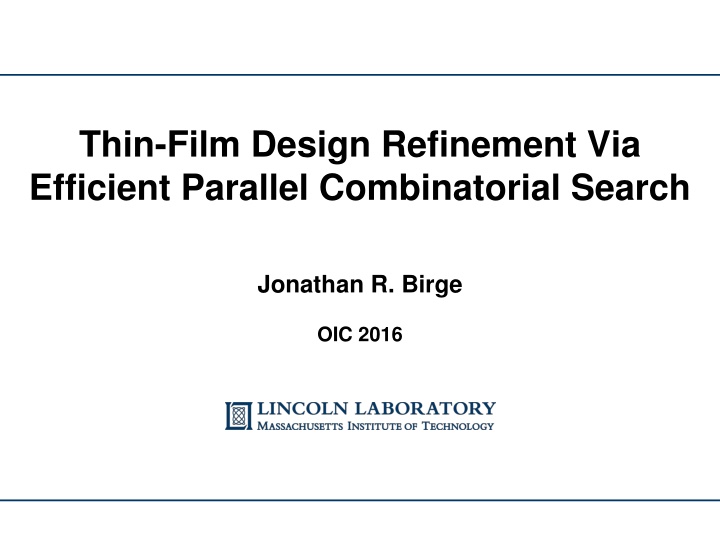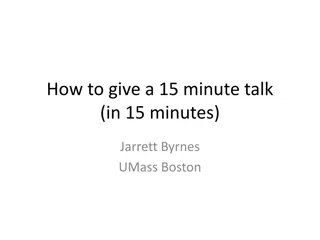
Efficient Thin Film Design Refinement and Parallel Combinatorial Search
Explore the efficient design refinement of thin films through parallel combinatorial search techniques. Discover the merit functions, combinatorial search concepts, and implementation efficiency for AR coating design. Witness the results of the 14-layer AR coating on a substrate, optimizing reflectivity with local optimal search methods.
Download Presentation

Please find below an Image/Link to download the presentation.
The content on the website is provided AS IS for your information and personal use only. It may not be sold, licensed, or shared on other websites without obtaining consent from the author. If you encounter any issues during the download, it is possible that the publisher has removed the file from their server.
You are allowed to download the files provided on this website for personal or commercial use, subject to the condition that they are used lawfully. All files are the property of their respective owners.
The content on the website is provided AS IS for your information and personal use only. It may not be sold, licensed, or shared on other websites without obtaining consent from the author.
E N D
Presentation Transcript
Thin-Film Design Refinement Via Efficient Parallel Combinatorial Search Jonathan R. Birge OIC 2016
Thin Film Merit Function Structure 14 layer AR coating on 1.52 substrate Uniform thin layer initial conditions low index: 1.35, high index: 2.35 Merit function of AR coating versus two layer thicknesses Local minima tend to be spaced quasi-uniformly by - to -wave of mean optical thickness Birge OIC - 2
Combinatorial Search Concept 14 layer AR coating on 1.52 substrate Uniform thin layer initial conditions low index: 1.35, high index: 2.35 Merit function of AR coating versus two layer thicknesses Notional start point k = 2 neighborhood Searching for better local minima can be done by simultaneously perturbing groups of k layers by enough to escape local minima and reoptimizing Birge OIC - 3
Parallelization Approach Initialization Asynchronous Scheduling Worker Node Worker Node (i,j,k,l) Worker Node Worker Node Master Node Master Node F Out: Indices to jump Back: Refined merit function from new start points Stack material data Starting position Merit function Worker Node Worker Node Dynamic computation assignment prioritizes uniform node utilization over communication efficiency in the face of unpredictable computation times Birge OIC - 4
Implementation Efficiency Computation time versus number of cores 128 64 32 Time (s) 16 8 4 2 1 8 16 32 64 128 256 512 Compute Nodes Computation time scales linearly with processor count Parallel algorithm is not communication-limited Birge OIC - 5
AR Coating Design Example 18 layer AR coating on 1.52 substrate Low index: 1.38, high index: 2.35 Trivial start point: uniform 1/20th mean wave layers k = 2 Reflectivity 0.005 0.0045 0.004 0.0035 0.003 Local Opt. Comb. Search 0.0025 Rav = 0.16% 0.002 0.0015 0.001 0.0005 Rav = 0.063% 0 0.4 0.5 0.6 0.7 0.8 Wavelength (um) Birge OIC - 6 *Following Dobrowolski et al, Optimal single-band normal-incidence antireflection coatings , Optics Letters 35 (1996)
AR Coating Design Results 14 layer AR coating on 1.52 substrate Low index: 1.38, high index: 2.35 k = 4 search space Combinatorial opt. from trivial start point 0.005 Rav = 0.072% Antireflection coating literature* Rav = 0.085% 0.004 0.003 N = 14 0.002 0.001 0 0.005 Rav = 0.052% Rav = 0.060% Reflectivity 0.004 0.003 N = 20 0.002 0.001 0 0.005 Rav = 0.045% Rav = 0.047% 0.004 N = 26 0.003 0.002 0.001 0 0.4 0.5 0.6 0.7 0.8 Wavelength (um) Wavelength (um) Birge OIC - 7 *J. A. Dobrowolski et al, Optimal single-band normal-incidence antireflection coatings , Optics Letters 35 (1996)
Future Work Test on other design genres Initial work on stop/pass-band shows promise, albeit not as dramatic as AR coating Integrate into larger optimization schemes (e.g. gradual refinement, needle optimization, etc.) Adaptive jump size determination Implement on commodity cloud hardware (e.g. Amazon EC2) Integrate with manufacturing tolerance merit functions Birge OIC - 8



















